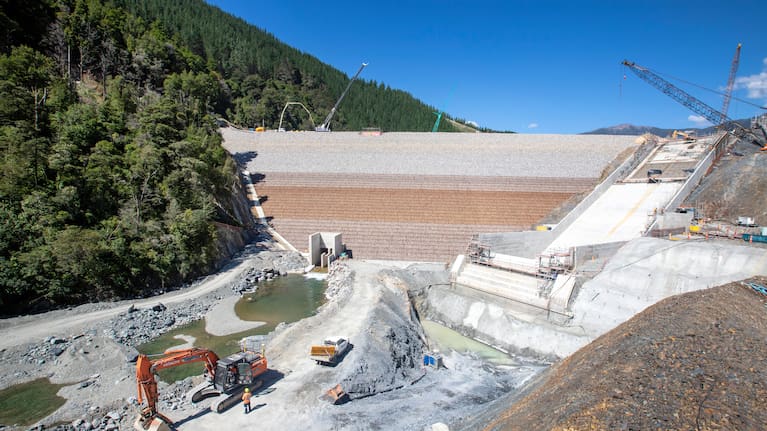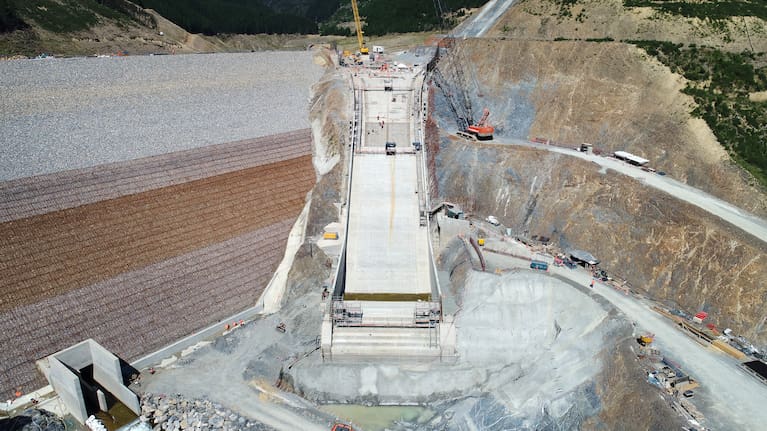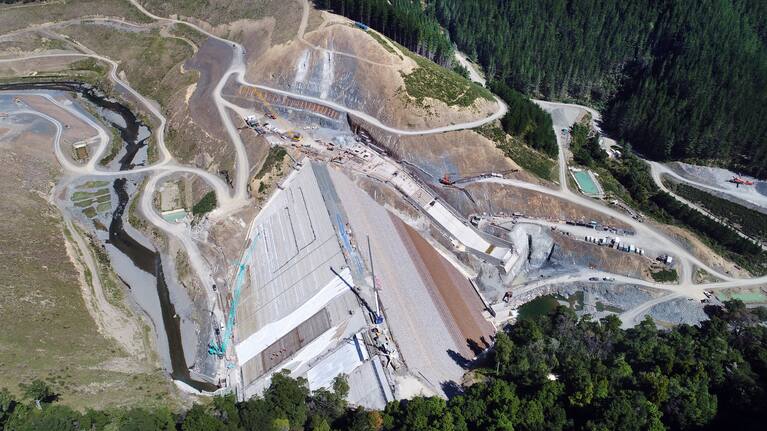The Waimea Dam at the top of the south is the largest public dam to be built in New Zealand in more than 20 years. While it's due to start filling with water later this year, it's behind schedule and way over budget.
1News took a tour of the dam that hopes to eventually provide water security for the Tasman region for the next 100 years.
It's about 75% complete with the large 50-metre high concrete face mostly in place.
Over the next few months, the spillway and parapet will be the focus.
The Waimea Community Dam is due to be filled with water later this year.
Waimea Water is responsible for the project. CEO Mike Scott says it's been challenging.
He points to the hill on the left-hand side which had to be carved into for the dam's construction.
"We have found that this geology on the left-hand side hasn't been what we expected. So rather than a nice hard sandstone we've got a much softer argillite material which has been, which breaks up very very easily," Scott says.
The budget blowout
The unexpected issues with geology are the main reason for the dramatic cost increases, alongside Covid-19 and supply chain issues.

When it was originally signed off by the Tasman District Council in 2018, the budget was $105 million. At last count, it's now $185 million.
Scott says everything possible has been done to keep costs down.
"Yes. I can assure ratepayers that we have worked our backsides off and engineered as hard as we can to keep the cost as low as possible."
Tasman Mayor Tim King says it's likely costs will rise.
"So given all the challenges around supply chains, material costs. I'm expecting to receive news of a further increase at some point in the next few months."
The project is a joint partnership between the Tasman District Council and local irrigators who were a driving force behind the dam.
Once the dam is complete, 51% will be owned by council and 49% by Waimea Irrigators. They share the cost of construction too, though exactly how it's funded is complex.
The main issue is that each time costs go up who pays the extra is re-negotiated.
Tim King says: "Currently the responsibility to pay the bills remains with the council. Then the council has to determine how that's going to be recovered from various different parties."
Waimea Irrigators chairperson Murray King says he's confident irrigators are paying their fair share "and then some".
The case for the Waimea Dam
The Waimea Dam was first mooted around 20 years ago. It was sparked, in part, by hot summers when rivers almost ran dry.
Multiple options were looked at to provide water security before the dam, located in the Lee Valley, was chosen.

Murray King says water allocations at that time were oversubscribed.
"It means the consents for irrigation had been over-allocated and so there wasn't enough water to go around and it also meant that we were under restrictions on a regular basis."
For a region like Tasman that relies on horticulture, water security is important.
"I mean you spend all year growing a high-value crop and then for it to fall over at the last minute because you can't finish it off because of irrigation restrictions t doesn't work for anyone," he says.
But it's not just about irrigators, Murray King says.
"At the end of the day, it's about water reliability and making sure that they can turn the tap on and they've got water when they want it."
Tim King says there are three key benefits to the region as a whole, which he says includes Nelson.
"The resilience and water supply to both urban - so that's houses - commercial businesses and industries. The same security and future provision of water for horticulture and agricultural industries on the Waimea plains.
"And the third and probably and one of the least recognised is the benefits recreationally and environmentally to the flow in the river," King says.
'Pull their finger out' - Ongoing criticism
The issue of the Waimea Dam has been fraught for many years. At one point the council itself voted against it because of the cost to ratepayers.

When 1News visited Queen Street in Richmond, it was almost impossible to find residents with anything positive to say about it.
One says it's taking too long and costing too much. Her message to the council is "they should pull their finger out".
Another says she isn't sure the council knows what it's doing and is concerned that future generations would be paying for it.
"As a ratepayer, it just seems like we're spending more and more money. Where's it going to end?"
One resident, out of more than a dozen, says she thinks it will benefit the region and supports it. But, she declined to be interviewed on camera.
Murray Dawson is a long-time dam opponent and says the case for it has been misrepresented.
"Well look, I have a little phrase. It's not needed and it won't work."
He says the dam was built in the wrong place and there was poor public consultation.
"I think, in general, what's happened is the dam promoters have looked at best-case scenarios everywhere."
Dawson says there should be a high level, independent public inquiry.
"I think there are many lessons to learn here which are wider than Tasman.
"I think the biggest impact is this, and this is important. This is going to crimp capital expenditure for decades."
The infrastructure deficit
Once eventually built the reservoir will hold up to 13 million cubic meters of water, or 13 billion litres.
It's a huge undertaking and the largest public dam to be built since Clive 30 years ago.
Some say the issues with the Waimea Dam are a reflection of how hard it is to build long-lasting infrastructure in New Zealand.
Waimea Water's Scott says he thinks it's more difficult than elsewhere.
"New Zealand personally, I think, is a tough place to build infrastructure. We probably don't have the fiscal or regulatory framework that other countries enjoy.
"We've been through 30 years of not really building any sort of significant large water infrastructure such as dams.
"In that time, the population has grown 45%. Obviously as most folk now the infrastructure in New Zealand has become decrepit and deficient and here we are building the first dam in a long time."
The Government's Three Waters reforms are designed, in part, to tackle some of those water infrastructure issues. But most people 1News spoke to said there isn't enough information about it to know what impact it would have on projects like the Waimea Dam.
Tim King says he doesn't think the reforms will necessarily help.
"I don't think it's exactly going to make the projects easy to deliver. It may make the decision around whether or not they go ahead and some of those political challenges that the current system has slightly easier to work through."
Construction of the dam is expected to be completed in the spring and it's possible water from it could be used this coming summer.


















SHARE ME